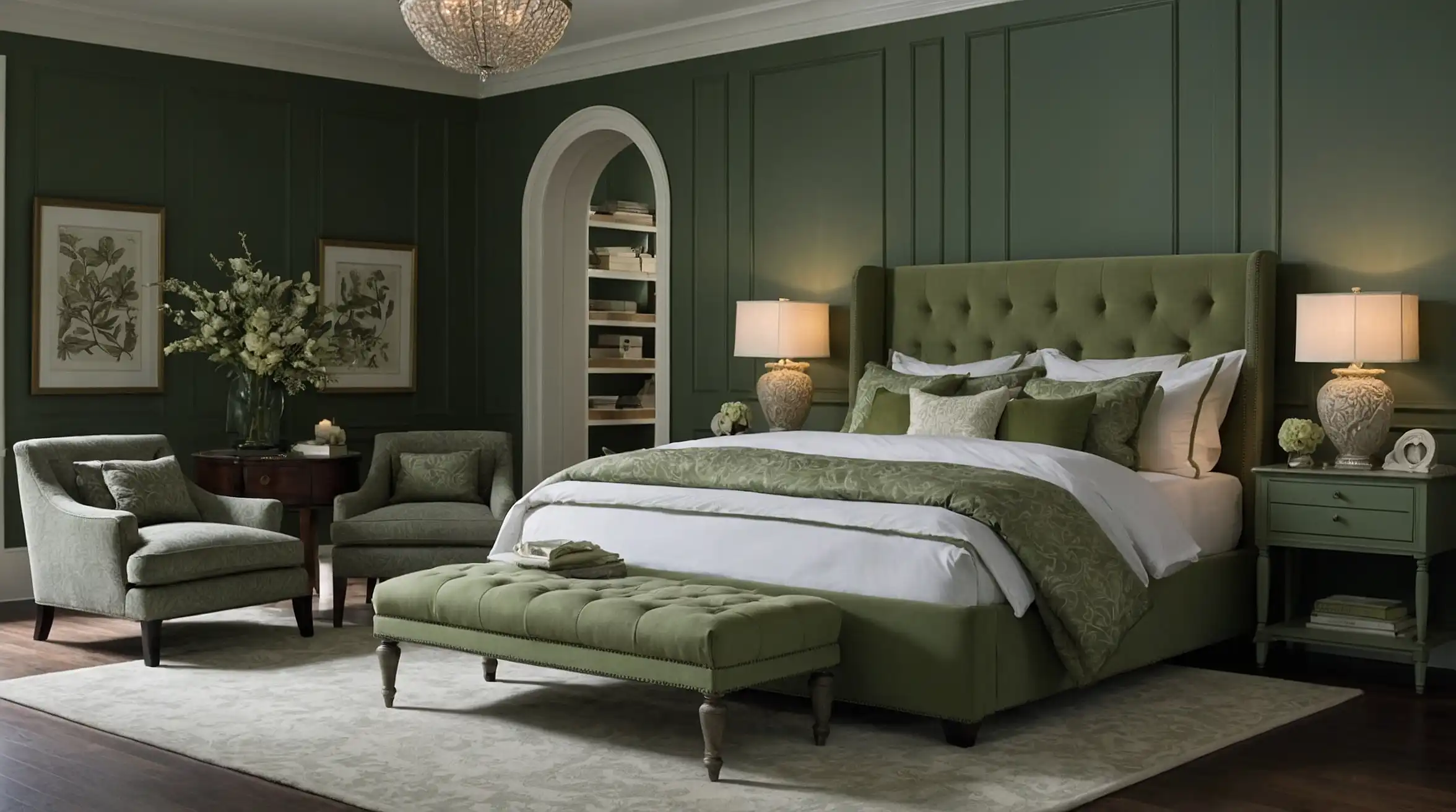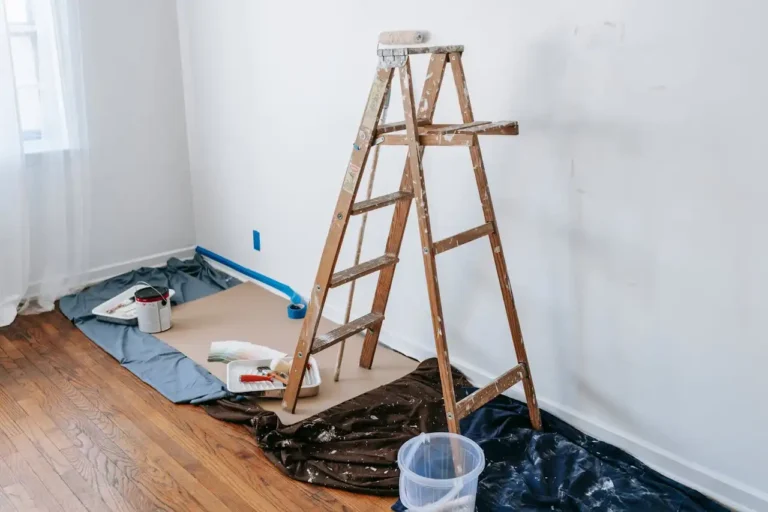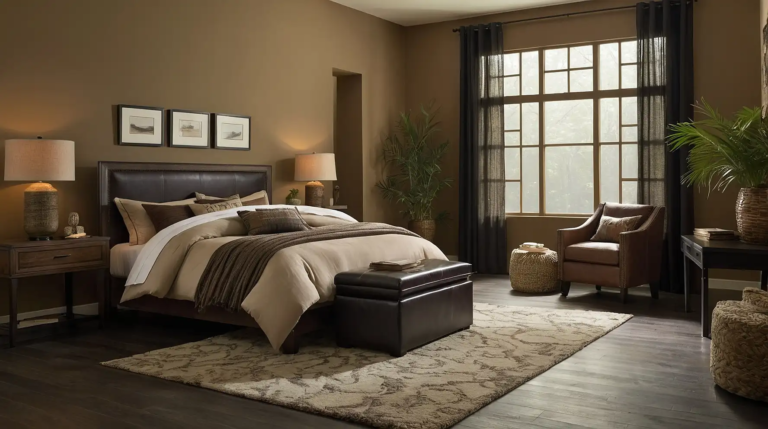27 Enchanting Sage Green Bedroom Ideas to Create Your Perfect Sleep Sanctuary
Sage green brings a calming, nature-inspired energy to bedroom spaces, making it an ideal choice for creating a restful environment.
This versatile shade bridges the gap between subtle neutrals and statement colors, offering endless decorating possibilities for any style preference.
Unlike bolder greens, sage provides a muted sophistication that works beautifully as both an accent and a primary color.
Its earthy undertones connect naturally with numerous complementary palettes from crisp whites to rich terracottas.
Whether you’re planning a complete bedroom transformation or simply looking to refresh your space with subtle sage accents, these 27 ideas will inspire you to incorporate this soothing hue into your personal retreat.
1: Sage Green Accent Wall
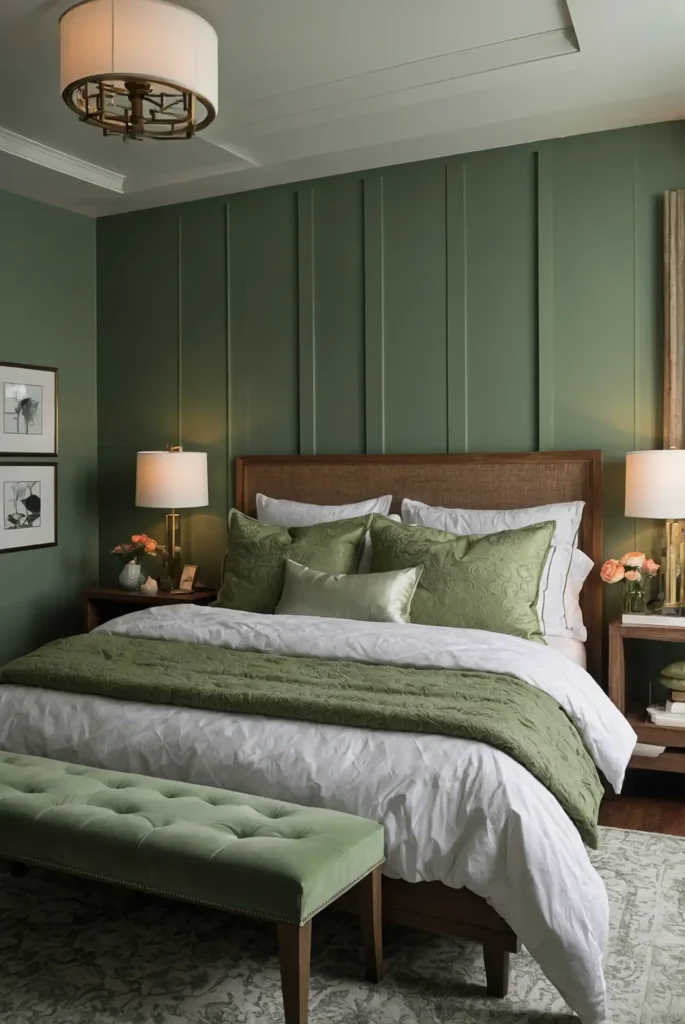
Create a focal point by painting just one wall in soothing sage green.
This approach adds color impact without overwhelming your space or requiring a full room commitment.
Choose the wall behind your headboard for maximum effect. Balance the green with neutral furniture and bedding to let the wall color shine.
Consider a matte finish for a sophisticated, velvety look that absorbs light beautifully.
2: Sage and White Contrast
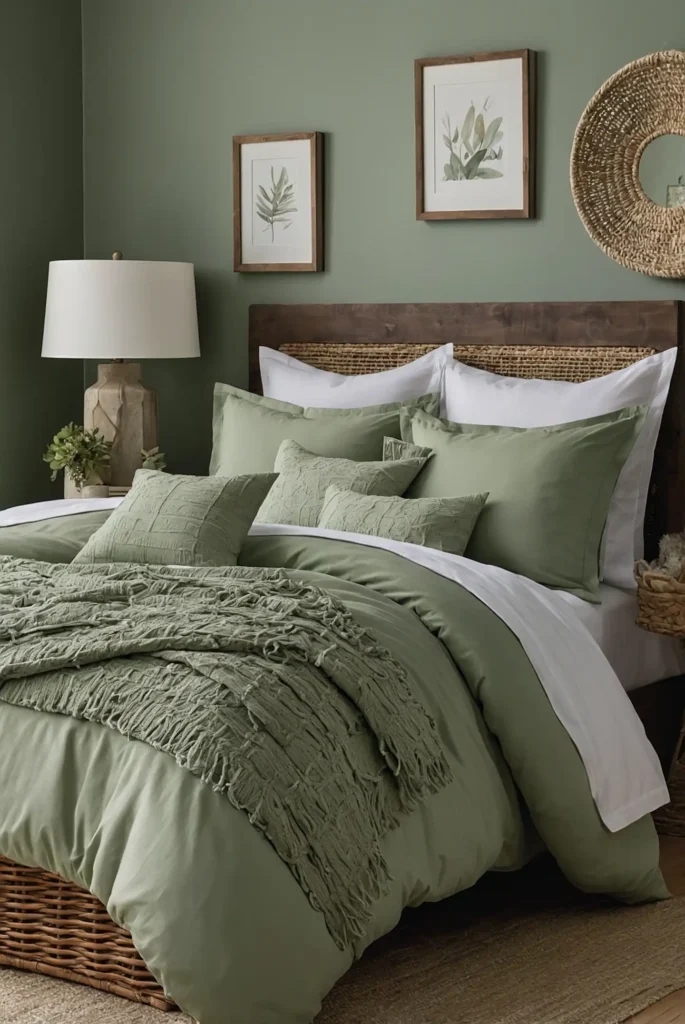
Pair sage green with crisp whites for a clean, refreshing bedroom palette. This classic combination creates a bright, airy feeling while maintaining visual interest.
Use white bedding against sage walls or introduce sage through accessories against white backgrounds.
Add textural elements like woven baskets or macramé to prevent the look from feeling flat.
Keep the ratio balanced—approximately 60% one color and 40% the other—for the most pleasing effect.
3: Sage Green Ceiling Treatment
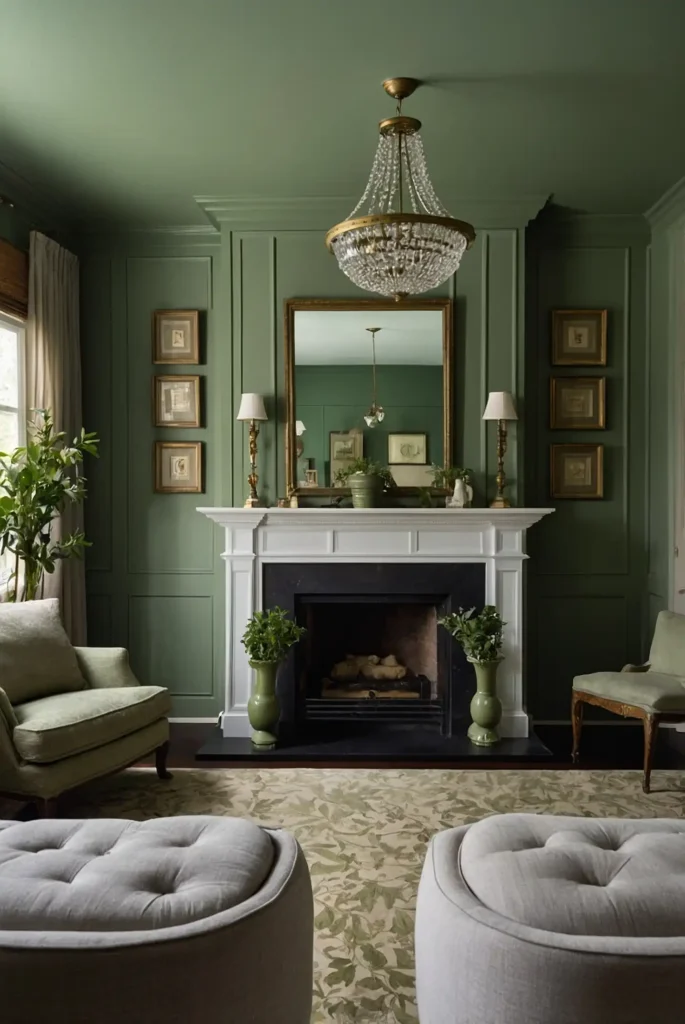
Paint your ceiling sage green while keeping walls neutral for an unexpected design element.
This technique draws the eye upward and creates a cocoon-like feeling of comfort.
Choose a slightly lighter shade than you might use for walls to prevent the ceiling from feeling heavy.
Add a statement light fixture in brass or matte black to create a focal point against the green backdrop.
Consider painting crown molding the same sage color for a seamless transition from walls to ceiling.
4: Layered Sage Textiles
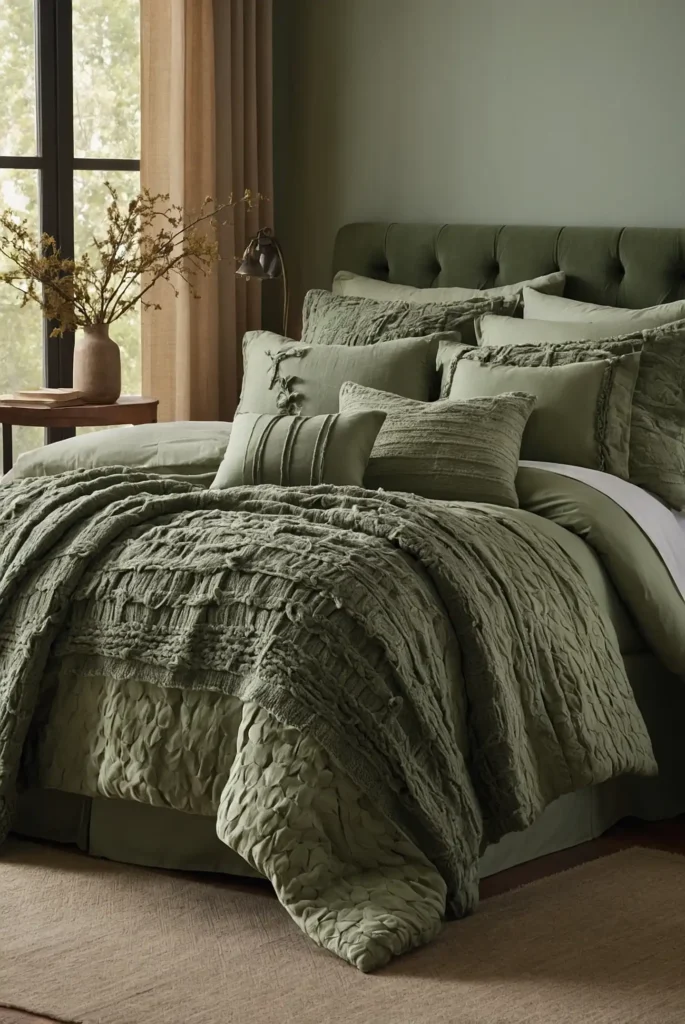
Create depth by incorporating various sage green fabrics with different textures throughout your bedroom.
This approach adds richness without requiring permanent changes.
Mix velvet, linen, cotton, and knits in similar sage tones across your bedding and window treatments.
Incorporate subtle patterns like tone-on-tone stripes or small-scale prints to add visual interest.
Add textured throw pillows and a chunky knit blanket to complete the layered, inviting look.
5: Sage and Gold Combination
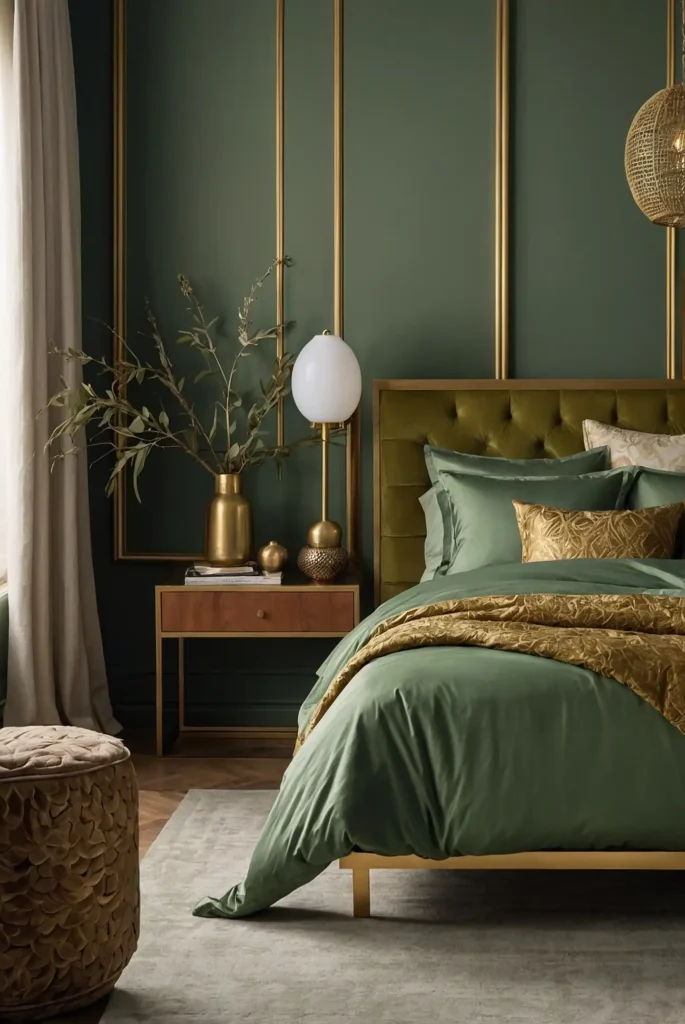
Pair sage green with warm gold accents for an elegant, nature-inspired bedroom palette.
The metallic elements add sophistication while complementing sage’s earthy character.
Choose gold light fixtures, mirror frames, and decorative objects for immediate impact.
Consider a gold-toned bed frame or nightstands to anchor the color scheme.
Keep wood tones warm and medium to maintain harmony with this color combination.
6: Sage Green Built-Ins
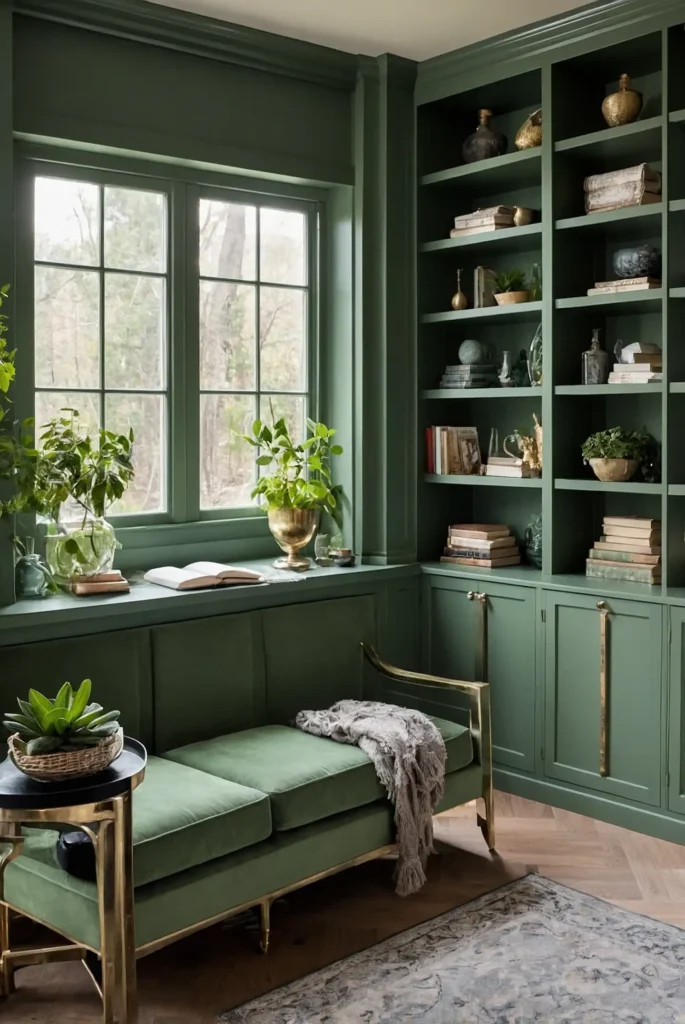
Install sage green built-in cabinetry, bookshelves, or window seats to add architectural interest and functional storage.
These permanent elements create elegant focal points with color impact.
Use semi-gloss or satin paint for durability and easy cleaning on these high-use surfaces.
Add contrasting hardware in brass, matte black, or crystal for definition and sparkle.
Style shelves with a mix of books, decorative objects, and small plants for a balanced, collected look.
7: Sage Upholstered Headboard
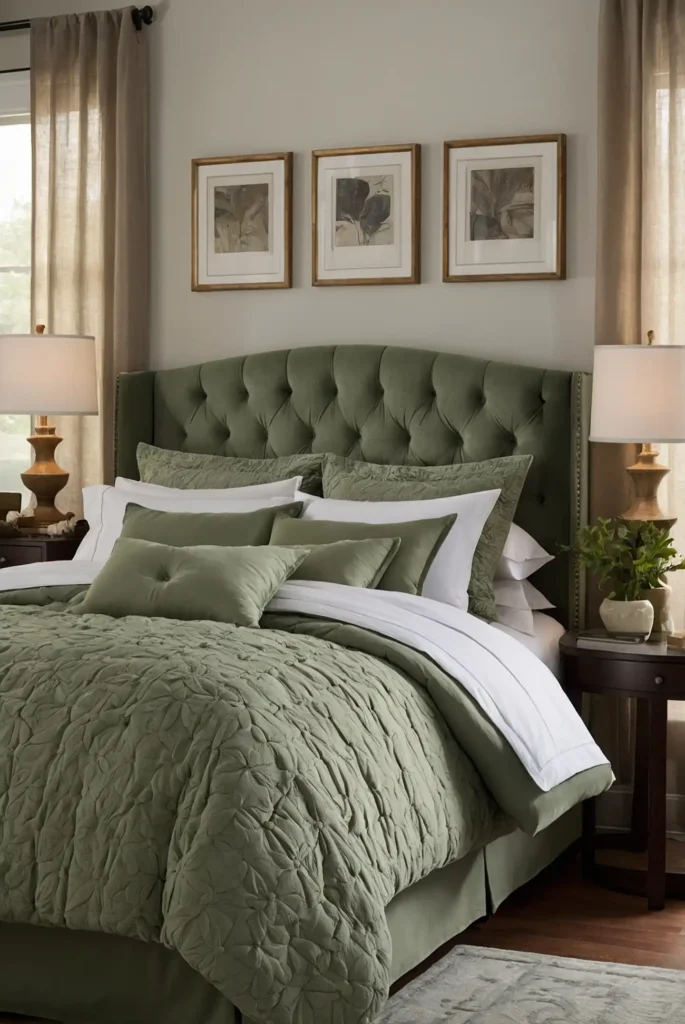
Install a plush sage green headboard as your bedroom’s centerpiece.
This single element adds color and texture while creating a comfortable focal point for your bed.
Choose performance velvet, linen, or textured weaves for visual interest and durability.
Add architectural details like channel tufting, nailhead trim, or a curved silhouette for extra character.
Keep bedding in complementary neutrals like whites, creams, or light grays to highlight your statement headboard.
8: Sage and Terracotta Accents
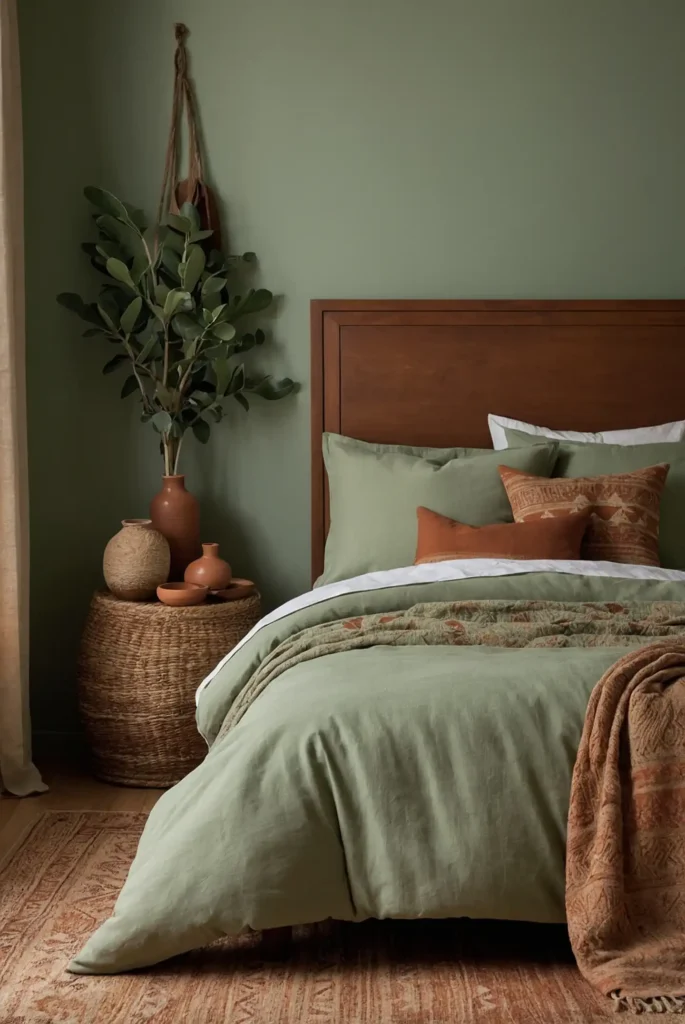
Warm up sage green with terracotta accents for an earthy, southwest-inspired bedroom palette.
This complementary combination feels both grounded and inviting.
Add terracotta through easily changeable elements like throw pillows, ceramic lamps, or artwork.
Include natural textures like rattan, jute, or unglazed pottery to enhance the organic feel.
Balance these earthy colors with plenty of white space to prevent the room from feeling too heavy.
9: Sage Wallpaper Feature
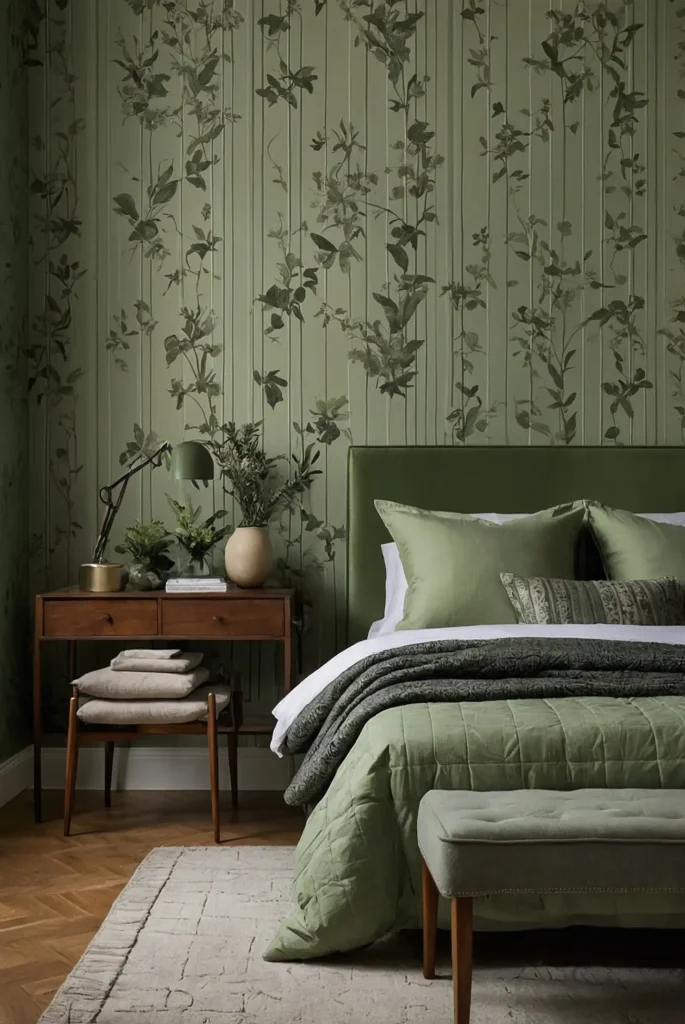
Install patterned wallpaper with a sage green background to add sophisticated visual interest.
This approach introduces pattern and texture while maintaining the calming green palette.
Choose botanical patterns for a nature-inspired look or geometric designs for a more contemporary feel.
Apply wallpaper to a single accent wall or consider the ceiling for unexpected design interest.
Pull complementary colors from your wallpaper pattern for other decorative elements in the room.
10: Sage Color Blocking
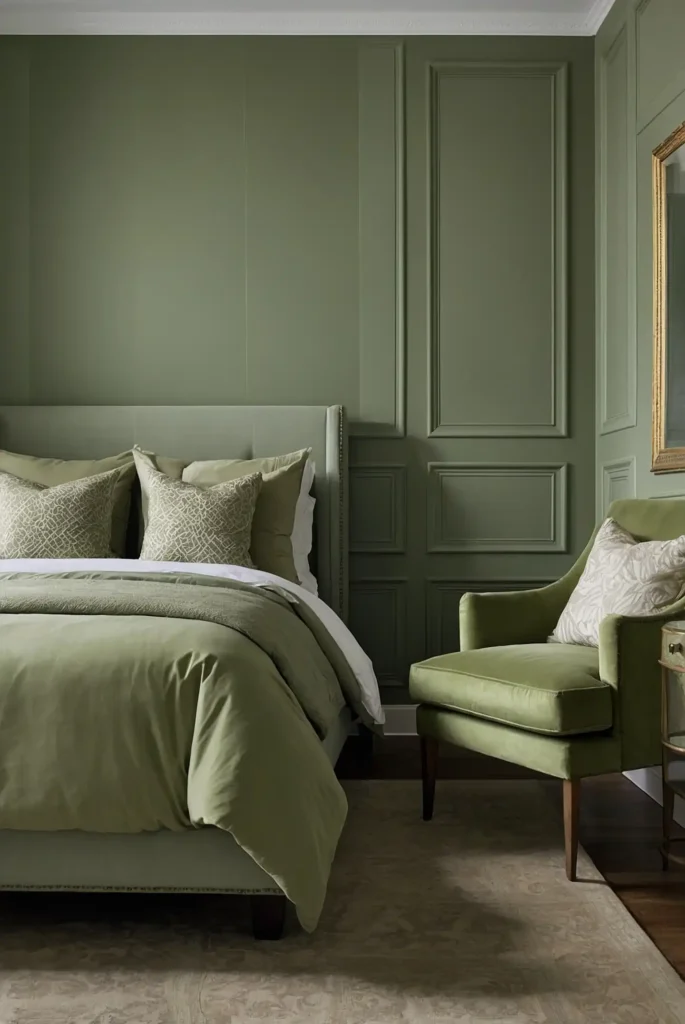
Create architectural interest by color-blocking with sage green and complementary hues.
This painting technique adds dimension without requiring actual structural changes.
Paint the lower third of walls in sage and the upper portion in a lighter neutral shade.
Add a thin chair rail or decorative tape line at the transition point for a finished look.
Consider painting interior doors or trim in your sage shade for cohesive color connection throughout the space.
11: Sage with Natural Wood
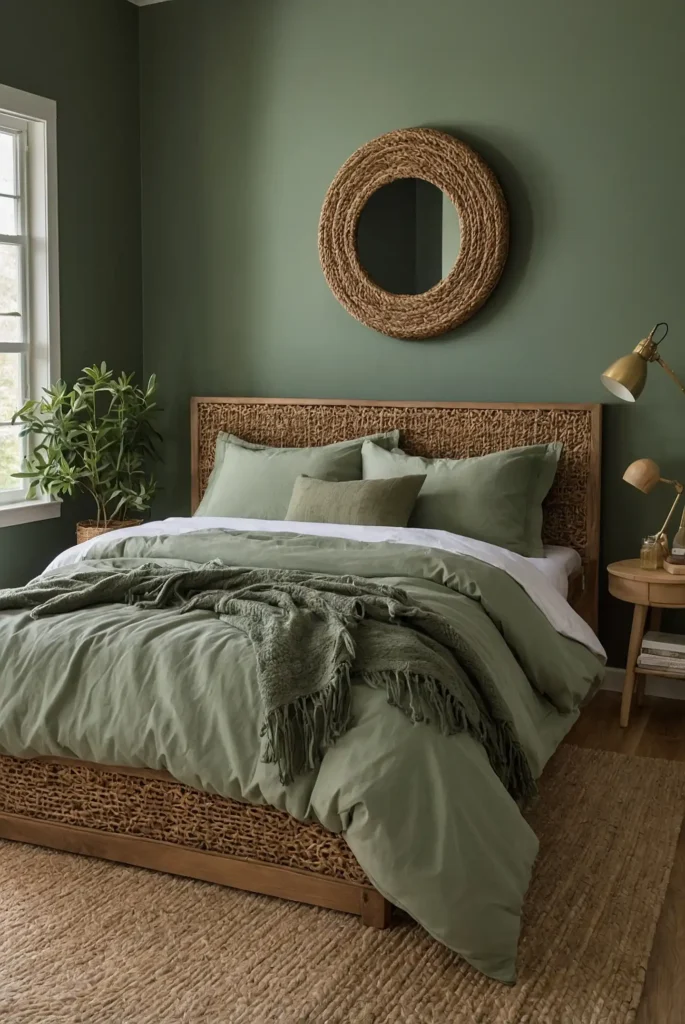
Balance the coolness of sage green with the warmth of natural wood elements.
This combination creates a grounded, organic feel perfect for relaxing bedroom retreats.
Incorporate wood through furniture pieces, flooring, or architectural elements like exposed beams.
Choose medium to light wood tones like oak, maple, or ash that complement sage’s natural character.
Add natural fiber textiles like jute, sisal, or linen to enhance the organic, earthy aesthetic.
12: Sage and Lavender Pairing
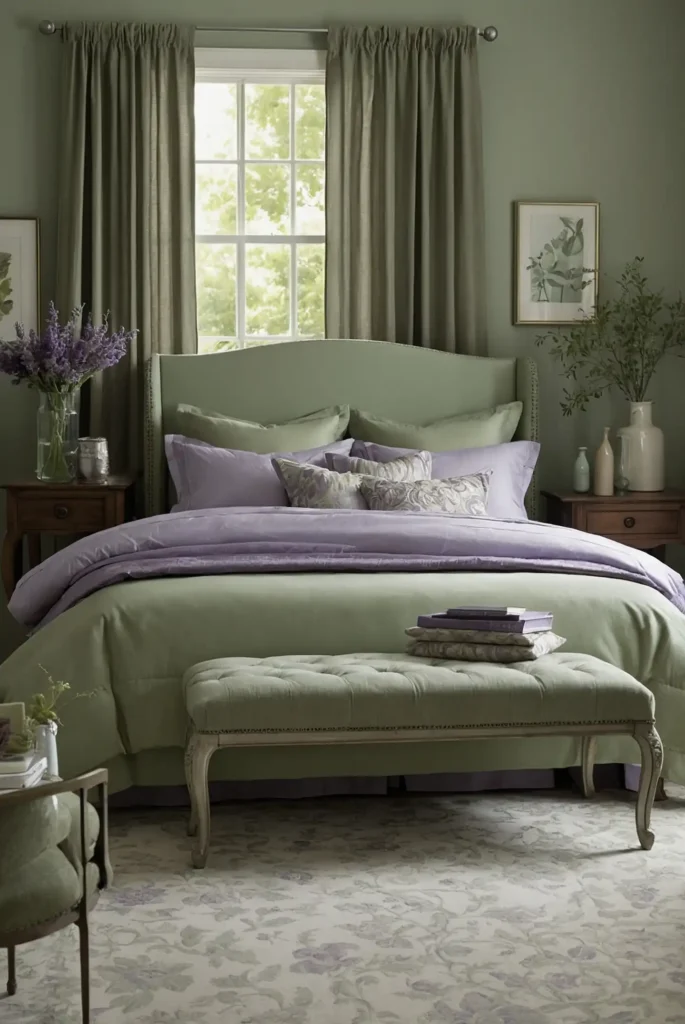
Combine sage green with soft lavender for a garden-inspired bedroom color scheme.
These complementary colors create a soothing, feminine space without being overly sweet.
Keep sage as your dominant color with lavender appearing in smaller doses through bedding, artwork, or fresh flowers.
Add white or cream elements to provide breathing space between these colors.
Consider silver or chrome accents rather than warm metals to enhance the cool, relaxing palette.
13: Sage Trim Detailing
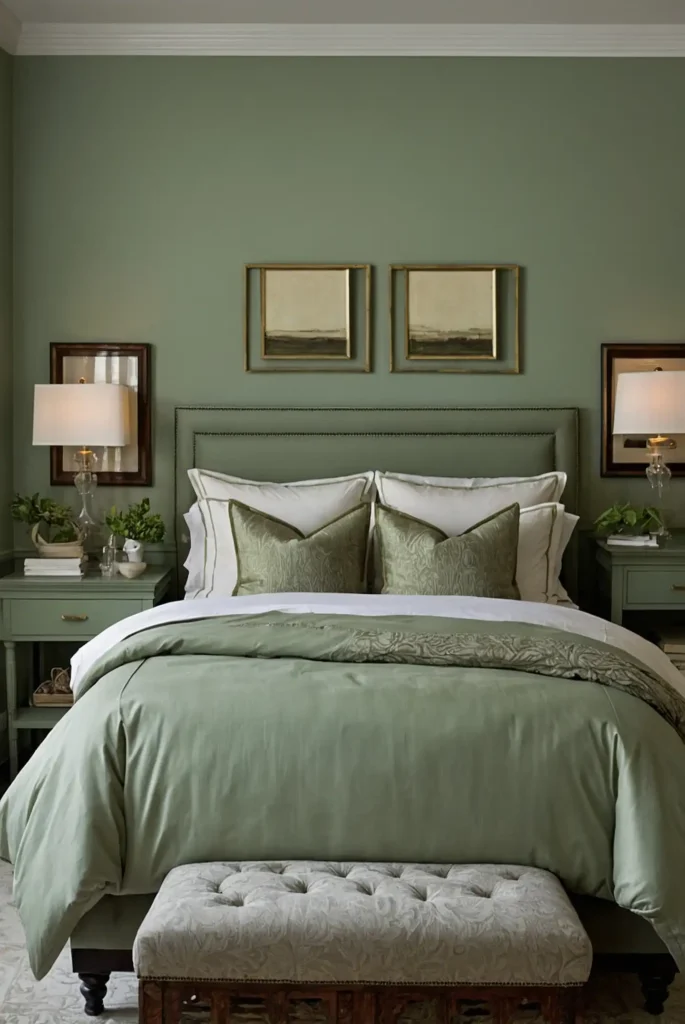
Highlight architectural features by painting just your trim, doors, or window frames in sage green.
This unexpected approach adds color while maintaining light wall space.
Choose satin or semi-gloss sage paint for trim to create subtle light reflection and practical durability.
Consider extending the treatment to ceiling moldings for a cohesive framed effect.
Keep walls neutral in white, cream, or the palest sage to maximize the contrast with your green trim.
14: Sage and Rattan Elements
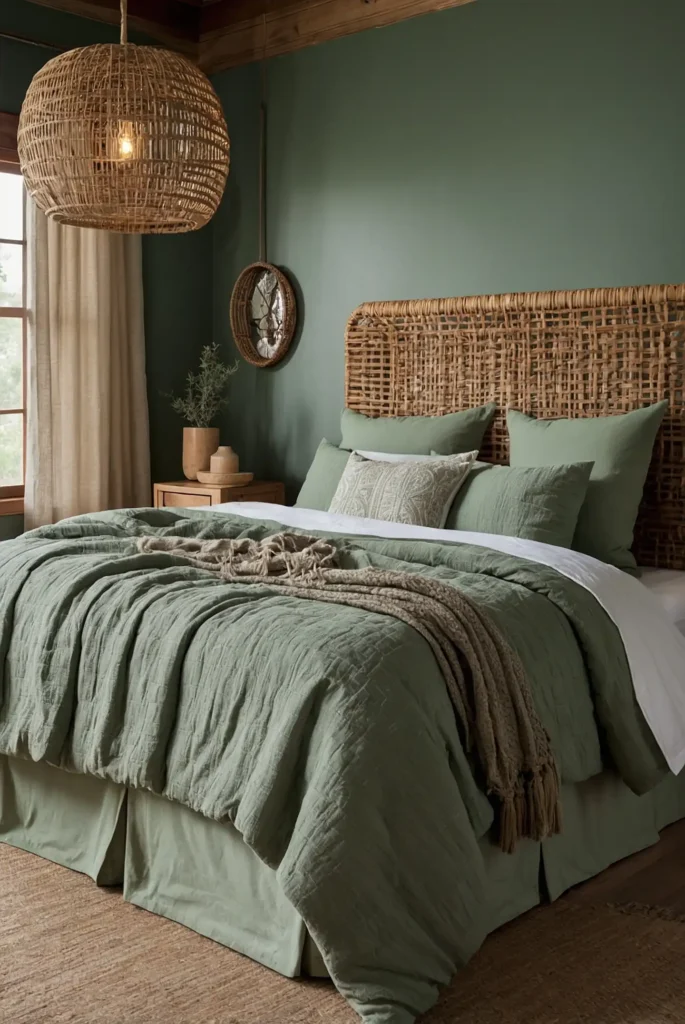
Incorporate natural rattan pieces into your sage bedroom for a relaxed, bohemian aesthetic.
This classic combination creates timeless, organic elegance with textural interest.
Choose rattan bed frames, nightstands, or lighting fixtures that provide warm contrast to cool sage tones.
Balance these substantial materials with softer textiles in complementary neutrals.
Add additional natural elements like potted plants or botanical artwork to enhance the nature-inspired theme.
15: Sage Bedding Centerpiece
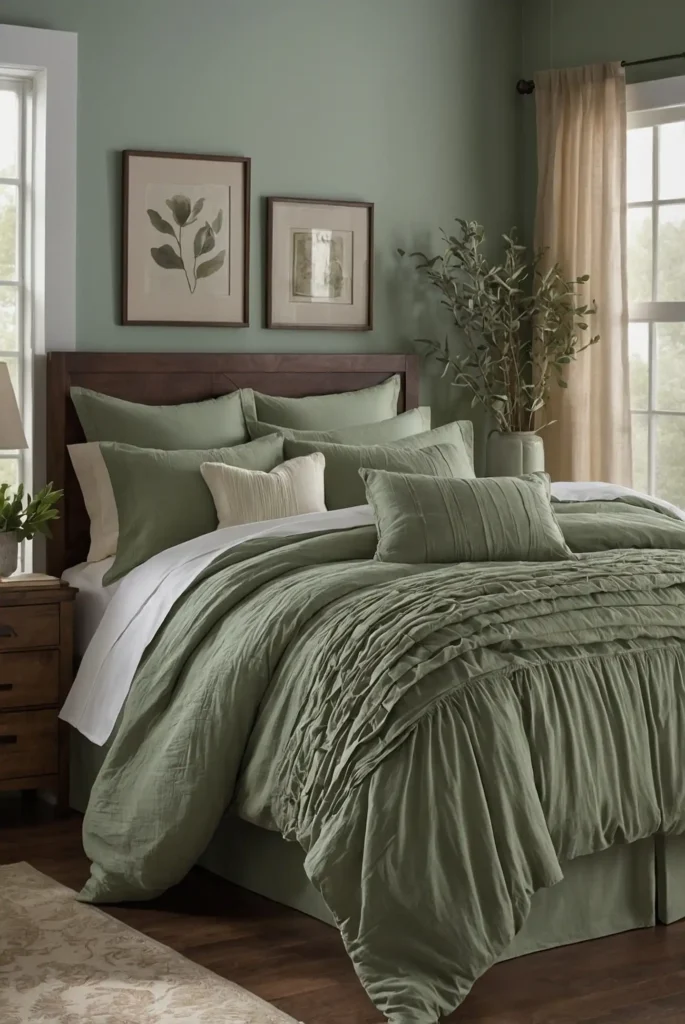
Make your bed the focal point with luxurious sage green linens while keeping walls neutral.
This approach provides color impact without the commitment of painted walls.
Choose high-quality cotton or linen bedding in sage for your duvet or comforter.
Layer with textured shams and accent pillows in complementary colors like cream, rust, or navy.
Add a lightweight, contrasting throw blanket across the foot of the bed to break up the sage expanse.
16: Sage and Blush Pink Accents
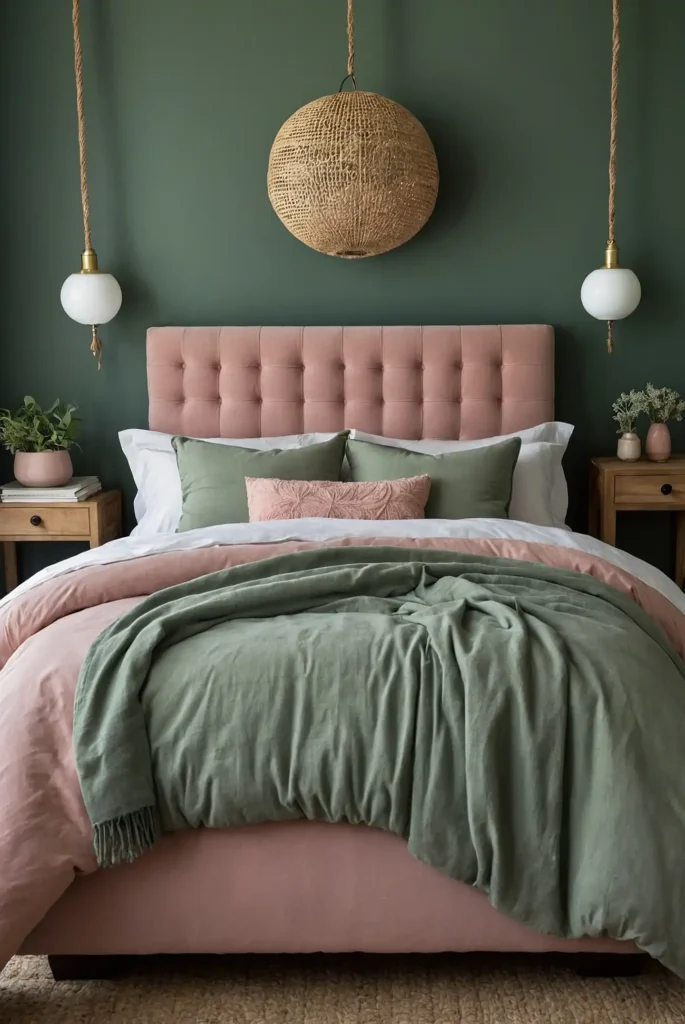
Soften sage green with blush pink accents for a delicate, sophisticated bedroom palette.
This unexpected color pairing feels fresh and contemporary without being trend-dependent.
Keep sage as your base with blush appearing in smaller doses through pillows, artwork, or a single statement chair.
Balance these colors with plenty of white or cream to maintain a light, airy feeling.
Add natural elements like fresh greenery or botanical prints to enhance the garden-inspired aesthetic.
17: Sage Patterned Area Rug
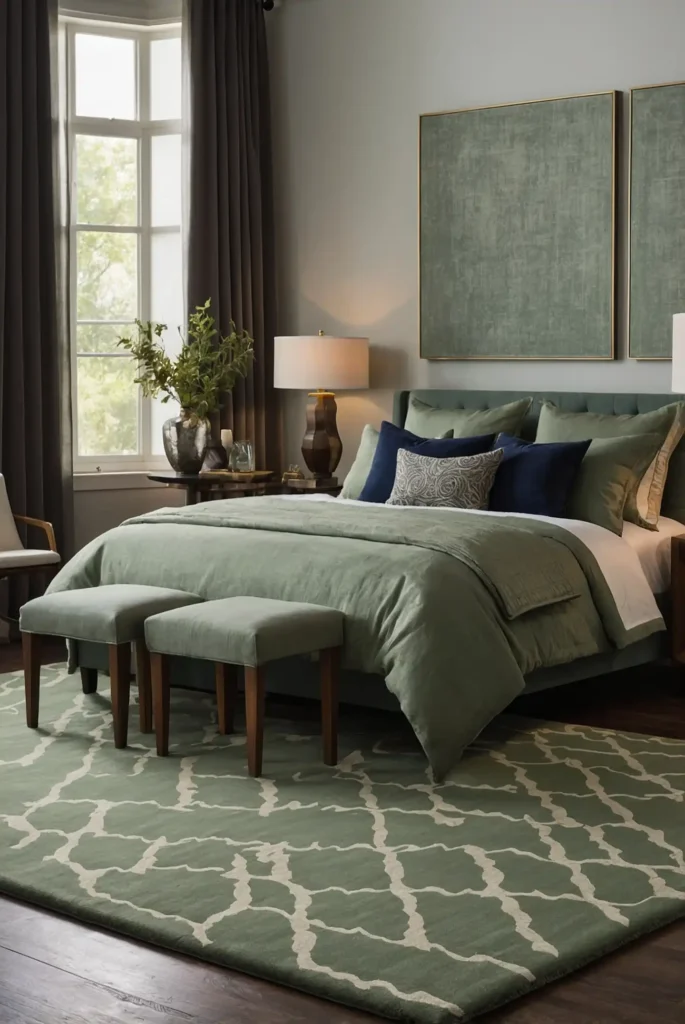
Anchor your bedroom design with a sage green area rug that adds color and texture from the ground up.
This foundation piece creates instant atmosphere without permanent commitment.
Choose traditional patterns like Persian or Oriental styles for classic elegance, or geometric designs for contemporary spaces.
Ensure the rug extends beyond your bed on all sides for proper proportion.
Pull accent colors from your rug pattern for other decorative elements like artwork or pillows.
18: Canopy Bed with Sage Draping
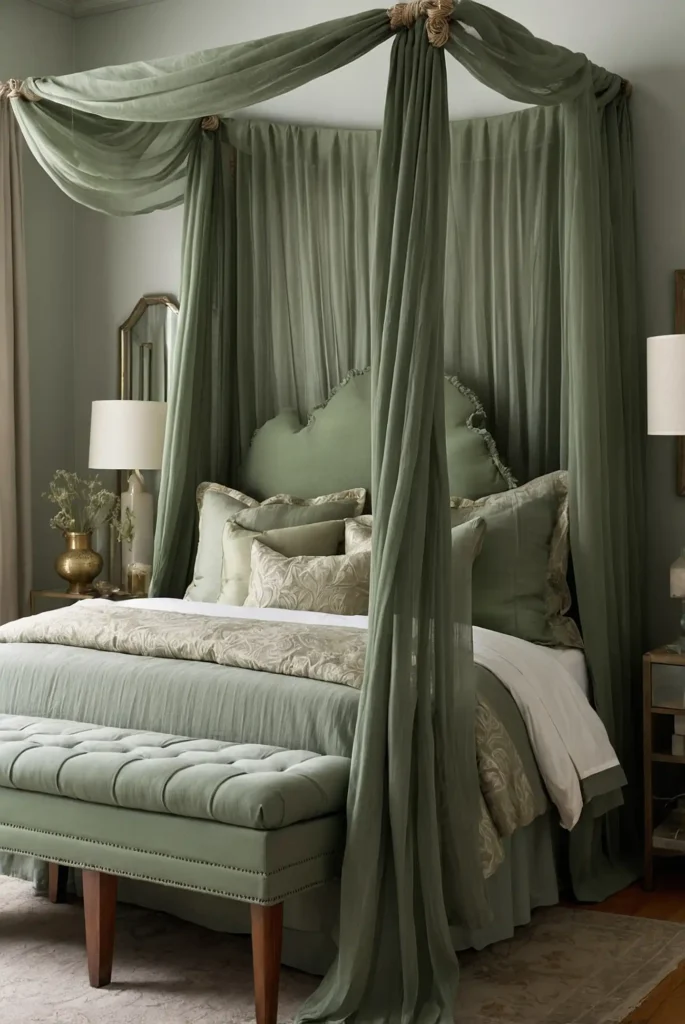
Create drama with flowing sage green fabric panels on a canopy bed frame.
This architectural element adds luxury while framing your sleeping space in soothing color.
Choose lightweight, semi-sheer fabrics like linen or gauze for an ethereal effect.
Consider subtle patterns like tone-on-tone stripes or small-scale prints if solid sage feels too heavy.
Keep bedding simple and light-colored to prevent the canopy treatment from feeling overwhelming.
19: Sage Gallery Wall
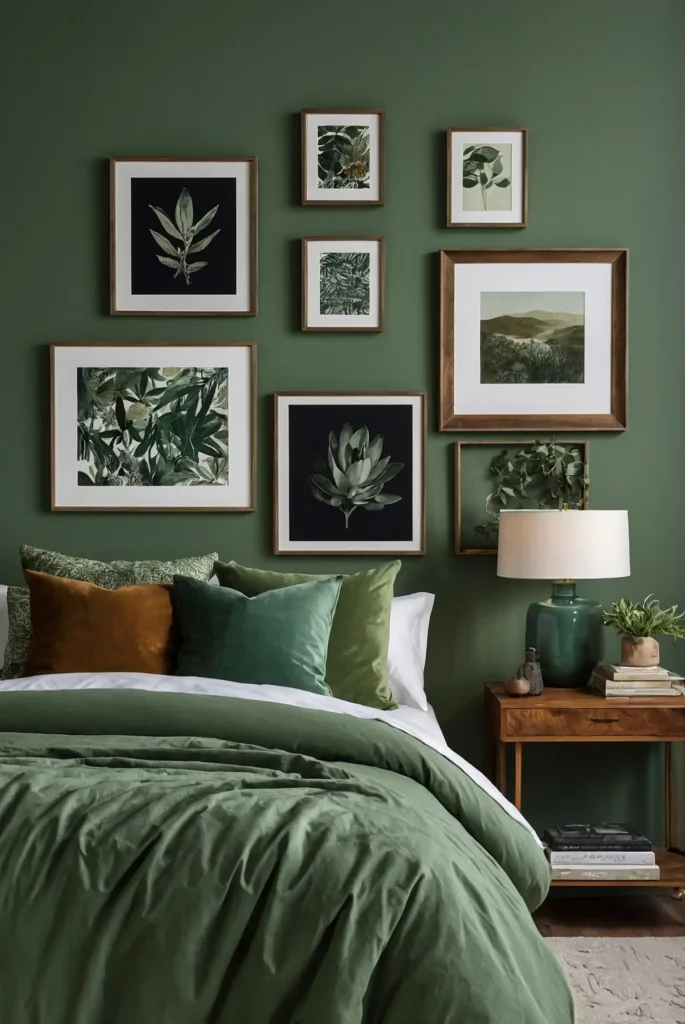
Display a curated collection of artwork against sage green walls to create a sophisticated gallery feature.
The subtle green background makes frames and art colors pop without competing.
Mix frame styles and sizes while maintaining a cohesive color palette in your artwork selections.
Include botanical prints, landscapes, or abstract pieces that complement your sage theme.
Consider adding picture lights or track lighting to properly illuminate your art collection.
20: Sage Botanical Theme
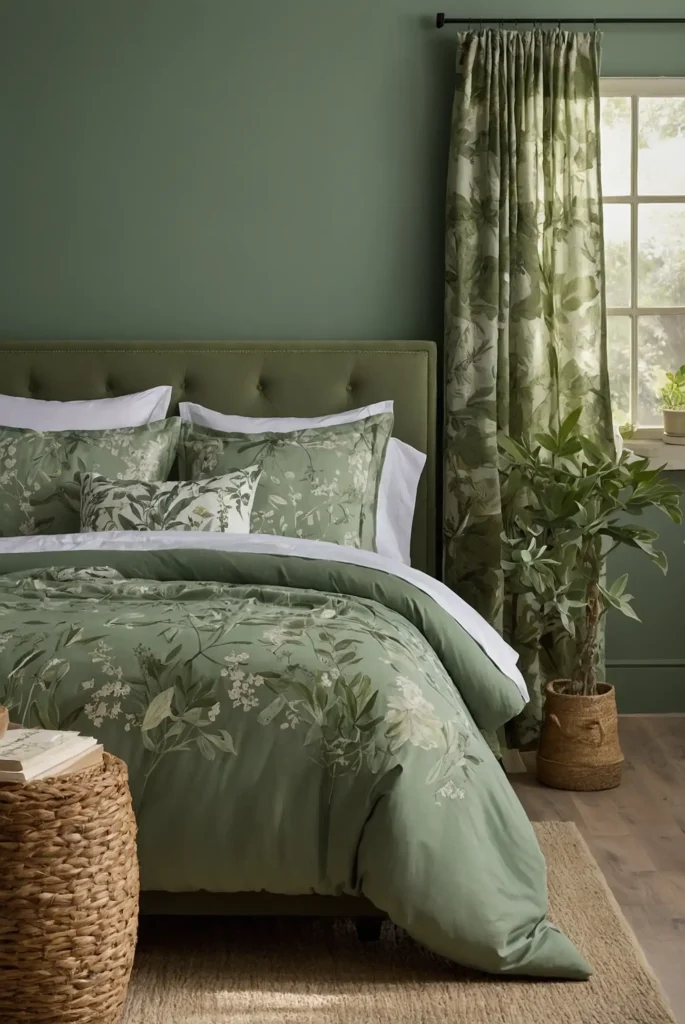
Incorporate natural elements and botanical motifs with your sage green color scheme for a fresh, garden-inspired retreat.
This combination enhances sage’s connection to nature.
Choose floral or leaf-patterned textiles that include sage in their palette.
Add living plants with interesting foliage shapes against sage backgrounds.
Display botanical prints or preserved plants in floating frames for natural artwork that complements your color scheme.
21: Two-Tone Sage Walls
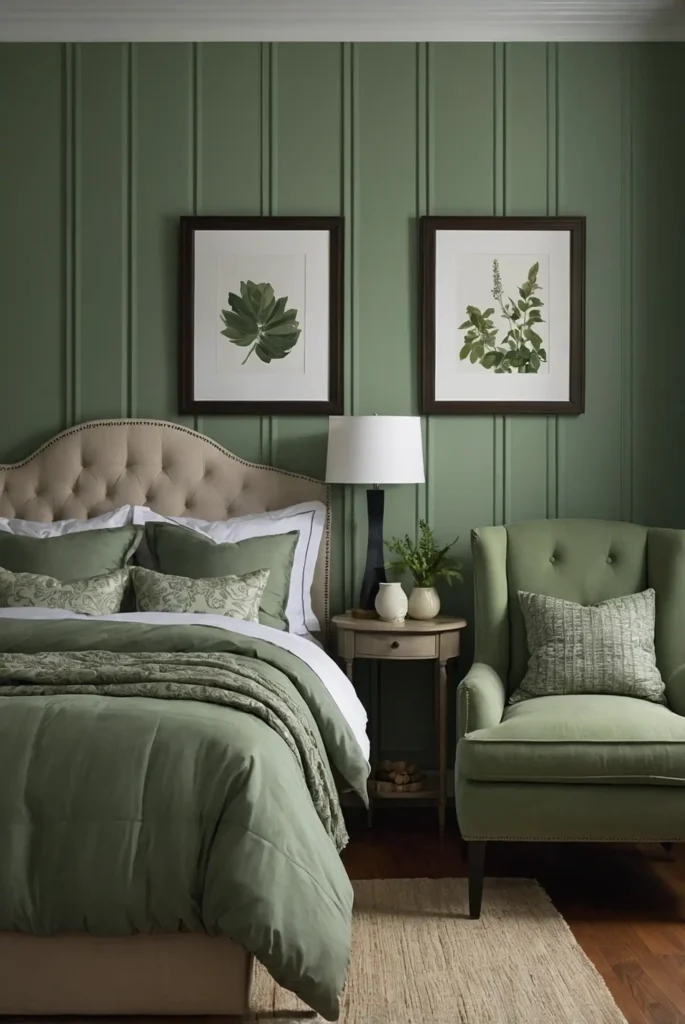
Create visual interest by using two different sage green tones on your walls.
This subtle variation adds depth while maintaining a cohesive color story.
Use the deeper sage on lower walls and the lighter shade above, with a thin molding dividing them.
Consider carrying the deeper tone onto built-in features like bookshelves or window seats.
Keep furnishings simple to let this sophisticated paint treatment take center stage.
22: Sage and Black Accents
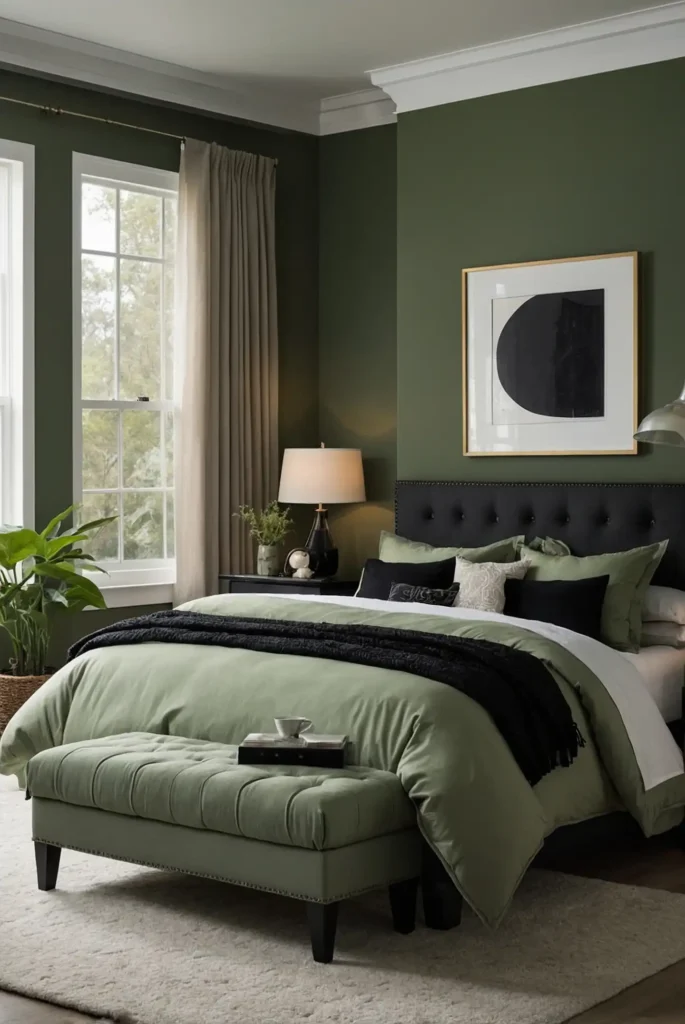
Add drama to sage green with black accents for a sophisticated, contemporary bedroom palette.
This high-contrast combination feels bold yet still calming.
Incorporate black through furniture frames, lighting fixtures, or window frames.
Balance these strong elements with plenty of light neutrals to prevent the space from feeling heavy.
Add textural elements like natural fibers or brushed metals to soften the contrast between sage and black.
23: Vintage-Inspired Sage Bedroom
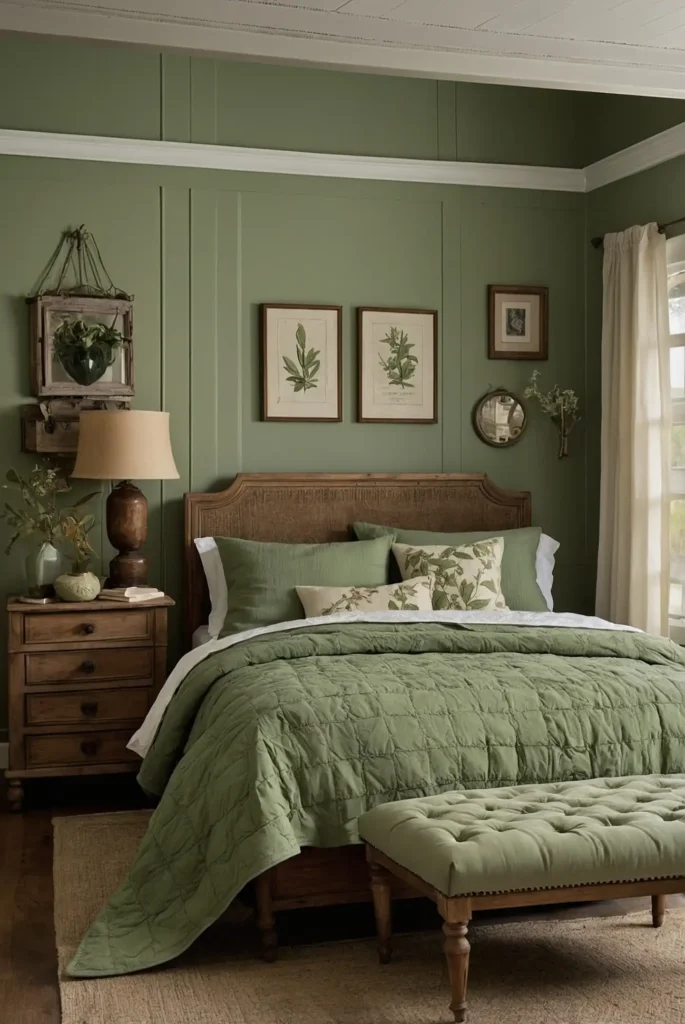
Design a nostalgic bedroom retreat using sage as your primary color with vintage furnishings and accessories.
This timeless approach creates cozy sophistication with character.
Hunt for antique or vintage-style wooden furniture pieces with patina and history.
Add crocheted throws, embroidered pillows, or heirloom quilts that incorporate sage tones.
Display vintage botanical prints, old books, or antique mirrors to enhance the collected-over-time aesthetic.
24: Sage Architectural Features
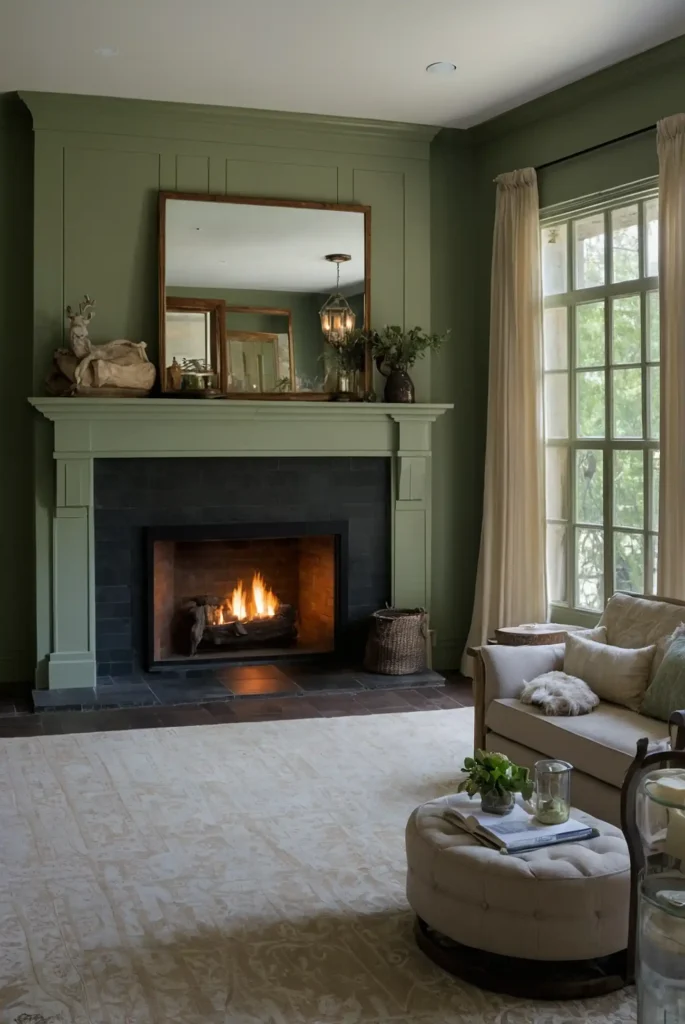
Highlight existing architectural elements like exposed beams, fireplace surrounds, or built-in bookshelves with sage green paint.
This technique adds color while celebrating your room’s unique features.
Keep surrounding walls lighter to create subtle contrast with your sage focal points.
Consider adding interior lighting to bookcase backs or niches to make sage surfaces come alive.
Choose a consistent sage shade throughout the room for accents to create visual connection.
25: Sage and Navy Combination
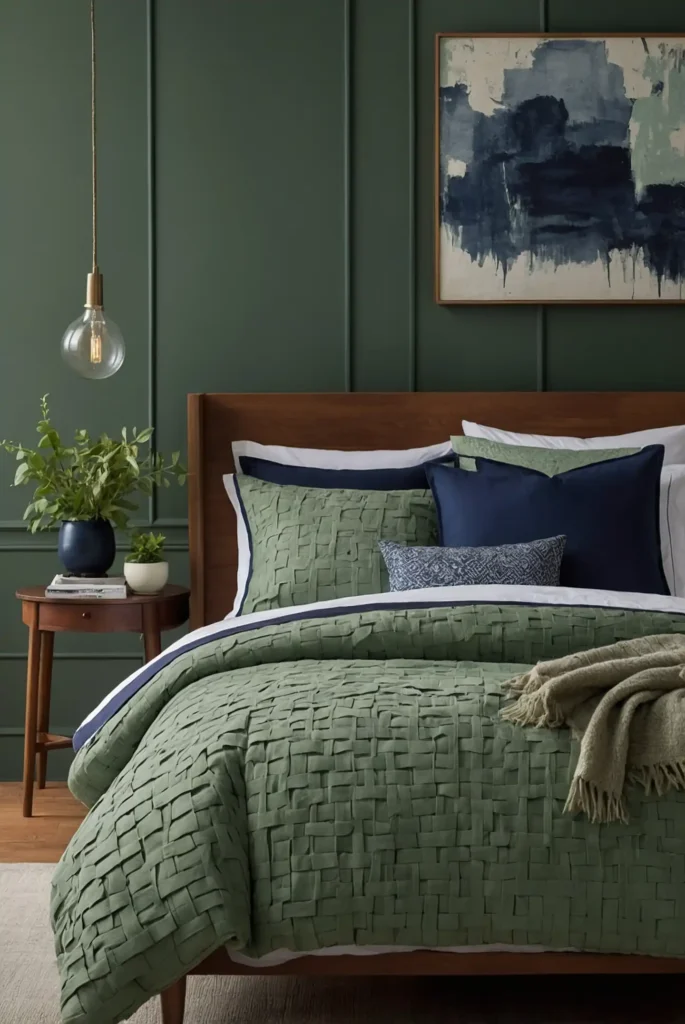
Pair sage green with navy blue for a sophisticated, grounded bedroom color scheme.
This classic combination feels both fresh and timeless.
Use sage as your primary color with navy appearing through accent furniture, textiles, or artwork.
Add natural elements like wood and woven textures to warm up these cool tones.
Consider patterns that incorporate both colors for pillows or area rugs to tie the scheme together.
26: Sage Velvet Elements
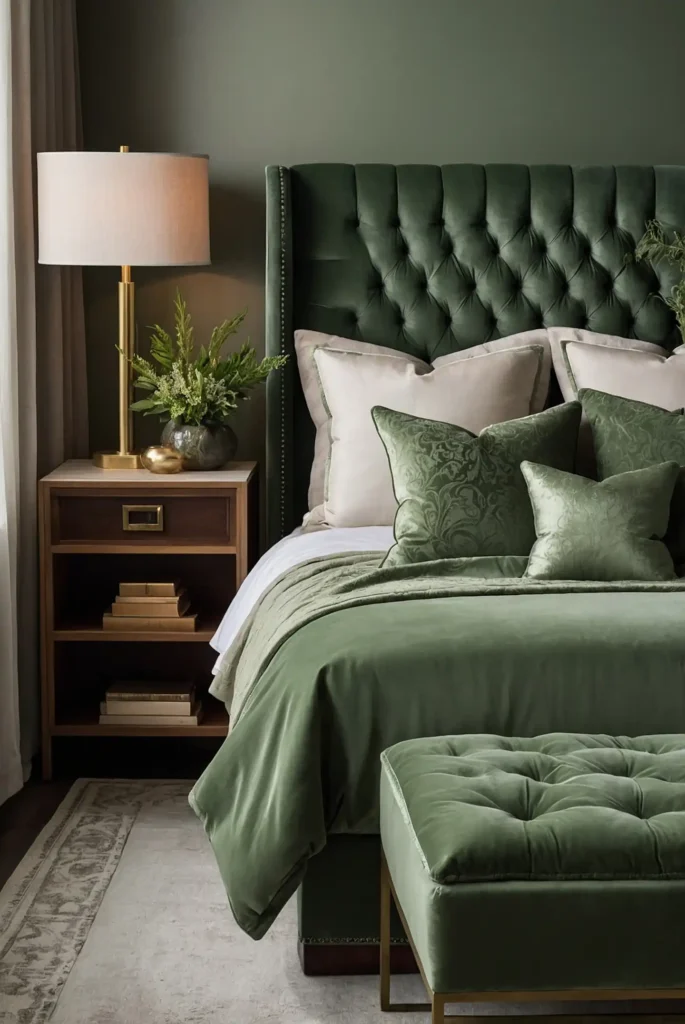
Add luxurious texture with sage green velvet upholstery or accents.
This sumptuous fabric adds depth and dimension to the muted color through its light-capturing properties.
Incorporate velvet through statement pieces like headboards, benches, or accent chairs.
Add smaller touches via pillow covers or throw blankets if larger pieces feel overwhelming.
Mix velvet with contrasting textures like crisp cotton, smooth leather, or natural linen to create tactile interest.
27: Minimalist Sage Approach
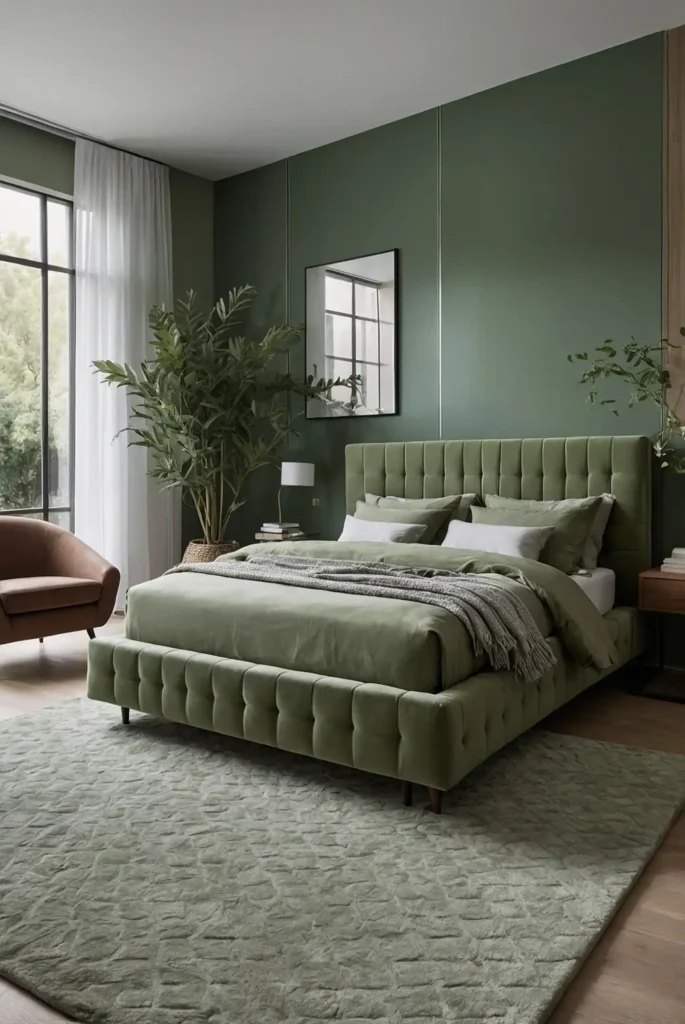
Embrace clean lines and simplified forms while using sage as your primary color for a modern, minimalist bedroom.
This approach creates calm sophistication without visual clutter.
Choose platform beds with simple headboards and streamlined furniture with hidden storage.
Limit your color palette to sage, white, and perhaps one accent color used sparingly.
Focus on quality materials and perfect proportions rather than numerous decorative elements.
Conclusion
Whether you embrace sage green fully with painted walls or simply incorporate touches through accessories, this versatile color creates refreshing, nature-inspired retreats.
Experiment with these ideas to discover your perfect sage sanctuary that balances tranquility with personality.

